ThisiscontentfromElsevier'sDrugInformation
Paclitaxel
Learn more about Elsevier's Drug Information today! Get the drug data and decision support you need, including TRUE Daily Updates™ including every day including weekends and holidays.
80 mg/m2 IV once weekly in combination with trastuzumab (4 mg/kg IV over 90 minutes on week 1, then 2 mg/kg IV over 30 minutes once weekly), every 21 days for 4 cycles (12 weeks). Administer after completion of 4 cycles of cyclophosphamide 500 mg/m2 IV, epirubicin (75 mg/m2 IV), and 5-FU (500 mg/m2 IV) on day 1, every 21 days for 4 cycles (FEC-75).[63560] [63561] Epirubicin dose adjustments for subsequent cycles are recommended by the manufacturer based on nadir platelet counts, ANC, or grade 3 to 4 toxicity.[41751] Surgery should be performed after completion of paclitaxel plus trastuzumab therapy, followed by trastuzumab 6 mg/kg IV every 3 weeks for a total of 52 weeks from the first preoperative dose. In a randomized, phase 3 clinical trial, neoadjuvant treatment with FEC-75 followed by paclitaxel plus trastuzumab (sequential therapy) resulted in similar rates of pathologic complete response (pCR), disease-free survival (DFS), and overall survival (OS) compared with paclitaxel plus trastuzumab followed by FEC-75 plus trastuzumab (concurrent therapy). Sequential therapy was better tolerated and had a lower incidence of cardiac adverse reactions.[63560] [63561]
175 mg/m2 IV over 3 hours every 3 weeks for 4 courses following completion of standard doxorubicin-based combination chemotherapy. In a study completed by the Cancer and Leukemia Group B (CALGB) Cooperative Research Group, the addition of sequential paclitaxel following standard combination chemotherapy with doxorubicin and cyclophosphamide reduced mortality by 26% and reduced the risk of recurrent breast cancer by 22% as compared to the combination alone.[29200] Alternately, paclitaxel 80 mg/m2 IV over 1 hour weekly for 12 weeks† significantly improved overall survival compared to every 3 week dosing in a phase 3 trial.[40586] Additionally, doxorubicin-based chemotherapy and sequential paclitaxel 175 mg/m2 IV have been administered every 14 days (dose-dense) for 4 courses.[47481] In patients with HER2-positive breast cancer, trastuzumab should be given in combination with paclitaxel.[28061]
175 mg/m2 IV over 3 hours every 3 weeks in combination with trastuzumab (4 mg/kg IV then 2 mg/kg IV weekly).
175 mg/m2 IV in combination with carboplatin (AUC 6 IV) beginning in week 1 and repeated every 3 weeks for 6 cycles; alternatively, paclitaxel 80 mg/m2 IV and carboplatin (AUC 2 IV) may be administered weekly for 3 weeks with a 1 week rest to complete six 4-week cycles. Give either regimen with trastuzumab (4 mg/kg IV infused over 90 minutes in week 1, then 2 mg/kg IV infused over 30 minutes weekly starting in week 2); continue trastuzumab until disease progression or unacceptable toxicity. A phase 3 trial of 196 patients with previously untreated HER2-overexpressing metastatic breast cancer examined trastuzumab and paclitaxel with or without carboplatin. The primary end point, overall response rate, was significantly increased with the addition of carboplatin (52% vs. 36%). Progression-free survival was also superior in the carboplatin arm (10.7 months vs. 7.1 months). Grade 4 neutropenia (36% vs. 12%) and grade 3 thrombocytopenia (9% vs. 1%) occurred more frequently in the carboplatin arm.[34295] A comparison of 2 parallel phase 2 studies revealed an increase in overall response rate, median time to disease progression, and overall survival with weekly administration of carboplatin/paclitaxel versus every-3-week administration.[34296]
90 mg/m2 on days 1, 8, and 15, every 28 days in combination with pembrolizumab (200 mg IV repeated every 3 weeks OR 400 mg IV repeated every 6 weeks until disease progression or up to 24 months in patients without progression); the number of cycles of paclitaxel was not specified.[66122] [66123] [57889] Administer pembrolizumab prior to chemotherapy when given on the same day. To prevent hypersensitivity reactions, all patients should be premedicated with dexamethasone 20 mg PO approximately 12 and 6 hours before paclitaxel, diphenhydramine 50 mg IV (or equivalent) 30 to 60 minutes before paclitaxel, and an IV H2-blocker 30 to 60 minutes before paclitaxel. In a multicenter, double-blind clinical trial (KEYNOTE-355), patients with locally recurrent unresectable or metastatic TNBC who had not been previously treated with chemotherapy in the metastatic setting were randomized to treatment with either pembrolizumab or placebo in combination with paclitaxel, nab-paclitaxel, or gemcitabine plus carboplatin regardless of tumor PD-L1 expression. The addition of pembrolizumab to chemotherapy significantly improved the median progression-free survival (9.7 months vs. 5.6 months) compared with placebo plus chemotherapy in the subgroup of patients with a CPS of 10 or more. The objective response rate was 53% compared with 40%, respectively (complete response, 17% vs. 13%) for a median duration of 19.3 months in the pembrolizumab arm and 7.3 months in the placebo arm.[57889] [66123]
175 mg/m2 IV over 3 hours on day 1 in combination with carboplatin AUC 6 IV on day 1, every 3 weeks for 6 cycles has been studied.[50012] [50011]
90 mg/m2 IV on days 1, 8, and 15 plus bevacizumab (10 mg/kg IV on days 1 and 15) given every 28 days has been studied. Treatment was continued until disease progression or unacceptable toxicity. Bevacizumab monotherapy could be continued at the discretion of the clinician, if unacceptable toxicity to paclitaxel developed while on combination treatment. In a phase III clinical trial of 722 patients with previously untreated metastatic breast cancer, paclitaxel was administered with or without bevacizumab. The primary end point, progression-free survival, was significantly improved in the bevacizumab/paclitaxel arm (11.8 months vs. 5.9 months), as was objective response rate (36.9% vs. 21.2%). However, overall survival was not significantly different between the treatment arms (26.7 months vs. 25.2 months). Grade 3 and 4 hypertension (14.8% vs. 0%), proteinuria (3.5% vs. 0%), neuropathy (23.6% vs. 17.6%), infection (9.3% vs. 2.9%), headaches (2.2% vs. 0%), fatigue (8.5% vs. 4.9%), and cerebrovascular ischemia (1.9% vs. 0%) all occurred significantly more frequently in the combination arm. Median duration of paclitaxel treatment in the combination arm was 7.1 months vs. 5.1 months in the paclitaxel alone arm. Of patients in the combination arm, 21.3% continued bevacizumab monotherapy for a median of 3.7 months after discontinuation of paclitaxel.[33131]
175 mg/m2 IV over 3 hours every 3 weeks.[29200] Doses of 135 mg/m2 to 175 mg/m2 IV over 3 hours, up to 250 mg/m2 IV over 24 hours, or 120 mg/m2 to 140 mg/m2 continuous IV for 96 hours (20 mg/m2 per day to 35 mg/m2 per day for 5 days continuous IV infusion) once every 3 weeks and 80 mg/m2 to 100 mg/m2 IV over 1 hour weekly have been studied in patients with metastatic disease.
NOTE: Paclitaxel has been designated an orphan drug by the FDA for this indication.
135 mg/m2 IV infused over 3 hours once every 3 weeks or 100 mg/m2 IV over 3 hours every 2 weeks (dose intensity 45—50 mg/m2/week). In trials evaluating these schedules, the every 3-week regimen was more toxic than the other. In addition, all patients with low performance status were treated with the every 2-week schedule. Initiate or repeat paclitaxel treatment only if the absolute neutrophil count (ANC) is 1000/mm3 or higher. Reduce subsequent courses of paclitaxel by 20% for patients who experience severe neutropenia (ANC less than 500/mm3) for a week or longer; hematopoietic growth factor support may be required. Doses of 175 mg/m2 IV over 3 hours once every 3 weeks have been used. In a study of patients with treatment-resistant AIDS-related Kaposi's sarcoma, paclitaxel 100 mg/m2 IV over 3 hours every 2 weeks lead to a 59% overall response rate. As these patients had received extensive prior chemotherapy, G-CSF was required in 55% of paclitaxel cycles.[25765]
135 mg/m2 IV over 24 hours on day 1, followed by cisplatin 75 mg/m2 IV, every 3 weeks. To prevent hypersensitivity reactions, all patients should be premedicated with dexamethasone 20 mg PO approximately 12 and 6 hours before paclitaxel, diphenhydramine 50 mg IV (or equivalent) 30 to 60 minutes before paclitaxel, and an IV H2-blocker 30 to 60 minutes before paclitaxel.[29200]
200 mg/m2 IV on day 1 in combination with carboplatin (AUC 6 IV) on day 1 given every 21 days produced an overall survival of 12.3 months in a phase 3 comparison of 4 chemotherapy doublets in advanced NSCLC.[34305] In another similar 4-arm phase 3 comparison, paclitaxel 225 mg/m2 IV on day 1 in combination with carboplatin (AUC 6 IV) on day 1 given every 21 days, produced an overall survival of 7.8 months, which was similar to the reference regimen of cisplatin and paclitaxel.[41098]
Paclitaxel 200 mg/m2 IV on day 1 in combination with gemcitabine 1000 mg/m2 IV on days 1 and 8, every 3 weeks has been given.[27129] Alternately, paclitaxel 175 mg/m2 IV on day 1 in combination with gemcitabine 1250 mg/m2 IV on days 1 and 8, every 3 weeks has also been given.[49473]
200 mg/m2 IV on day 1 and carboplatin (AUC 6 IV on day 1) repeated every 3 weeks for 4 cycles in combination with pembrolizumab (200 mg IV every 3 weeks OR 400 mg IV every 6 weeks until disease progression or up to a maximum of 24 months). Administer pembrolizumab prior to chemotherapy when given on the same day. In a multicenter, randomized, double-blind clinical trial (KEYNOTE-407), treatment with pembrolizumab plus carboplatin and either paclitaxel or nab-paclitaxel (n = 278) significantly improved median overall survival (17.1 months vs. 11.6 months) and progression-free survival (6.4 months vs. 4.8 months) compared with placebo plus carboplatin and paclitaxel/nab-paclitaxel (n = 281) in patients with metastatic squamous NSCLC. The overall response rate was also significantly improved in the pembrolizumab arm (58% vs. 35%), for a median duration of 7.2 months and 4.9 months, respectively.[57889] [66530]
200 mg/m2 IV over 3 hours on day 1, preceded by bevacizumab (15 mg/kg IV over 90 minutes), and followed by carboplatin (AUC 6 IV), every 3 weeks for 6 cycles of chemotherapy. The sequence of administration should be bevacizumab followed by paclitaxel, and then carboplatin. After completion of chemotherapy, continue bevacizumab (15 mg/kg IV), on day 1 of each 21-day cycle until disease progression or unacceptable toxicity. To prevent hypersensitivity reactions, all patients should be premedicated with dexamethasone 20 mg PO approximately 12 and 6 hours before paclitaxel, diphenhydramine (or equivalent) 50 mg IV 30 to 60 minutes before paclitaxel, and an IV H2-blocker 30 to 60 minutes before paclitaxel. If the first bevacizumab infusion is well tolerated, the second infusion may be given over 60 minutes; if the 60-minute infusion is well tolerated, subsequent infusions may be given over 30 minutes. In a randomized, open-label clinical trial (n = 878), median overall survival was significantly longer in chemotherapy-naive patients with locally advanced, metastatic, or recurrent nonsquamous NSCLC treated with bevacizumab/paclitaxel/carboplatin (BCP) compared with paclitaxel/carboplatin (CP) alone (12.3 months vs. 10.3 months); investigator-assessed progression-free survival (PFS) was also longer in the bevacizumab arm. In an exploratory analysis, the impact of bevacizumab was not significant in women, patients age 65 years and older, or in patients with weight loss of 5% or more at study entry.[60402]
200 mg/m2 IV on day 1, or 175 mg/m2 IV in Asian patients, every 3 weeks for a maximum of 4 to 6 cycles. To prevent hypersensitivity reactions, all patients should be premedicated with dexamethasone 20 mg PO approximately 12 and 6 hours before paclitaxel, diphenhydramine (or equivalent) 50 mg IV 30 to 60 minutes before paclitaxel, and an IV H2-blocker 30 to 60 minutes before paclitaxel. Administer in combination with atezolizumab (840 mg IV every 2 weeks; OR 1,200 mg IV every 3 weeks; OR 1,680 mg IV every 4 weeks until disease progression or unacceptable toxicity), bevacizumab (15 mg/kg IV until disease progression or unacceptable toxicity), and carboplatin (AUC 6 IV every 3 weeks for a maximum of 4 to 6 cycles). Administer atezolizumab prior to bevacizumab and chemotherapy when given on the same day. Coadministration of certain drugs may need to be avoided or dosage adjustments may be necessary; review drug interactions. At the final analysis of a multicenter, randomized, open-label, phase 3 clinical trial (IMpower150), treatment with atezolizumab plus bevacizumab/paclitaxel/carboplatin (ABCP) significantly improved overall survival in patients with metastatic nonsquamous NSCLC compared with BCP without atezolizumab (19.5 months vs. 14.7 months); overall survival with atezolizumab/paclitaxel/carboplatin was not significantly different from BCP.[71232] Progression-free survival was also significantly improved in the ABCP arm compared with BCP (8.5 months vs. 7 months). The objective response rate was 55% (complete response [CR], 4%) versus 42% (CR, 1%), respectively, for a median duration of 10.8 months and 6.5 months, respectively.[60793] [63819]
200 mg/m2 IV (or 175 mg/m2 IV in Asian patients) in combination with carboplatin (AUC 6 IV) every 3 weeks for a maximum of 4 to 6 cycles. Administer in combination with bevacizumab (15 mg/kg IV) and atezolizumab; hyaluronidase (1,875 mg atezolizumab and 30,000 units hyaluronidase subcutaneously), both continued until disease progression or unacceptable toxicity. Administer atezolizumab; hyaluronidase prior to bevacizumab and chemotherapy when given on the same day. The use of atezolizumab; hyaluronidase for this indication is supported by evidence from adequate and well-controlled studies with intravenous atezolizumab in this population and pharmacokinetic data demonstrating comparable exposure to atezolizumab between the subcutaneous and intravenous products.[71223] At the final analysis of a multicenter, randomized, open-label, phase 3 clinical trial (IMpower150), treatment with atezolizumab plus bevacizumab/paclitaxel/carboplatin (ABCP) significantly improved overall survival in patients with metastatic nonsquamous NSCLC compared with BCP without atezolizumab (19.5 months vs. 14.7 months); overall survival with atezolizumab/paclitaxel/carboplatin was not significantly different from BCP.[71232] Progression-free survival was also significantly improved in the ABCP arm compared with BCP (8.5 months vs. 7 months). The objective response rate was 55% (complete response [CR], 4%) versus 42% (CR, 1%), respectively, for a median duration of 10.8 months and 6.5 months, respectively.[63819]
135 mg/m2 IV over 24 hours or 175 mg/m2 IV over 3 hours once every 3 weeks, followed by cisplatin (75 mg/m2 IV). This combination improves duration of progression-free survival and overall survival of these women as compared to the combination of cyclophosphamide and cisplatin.[25761] The 3-hour paclitaxel infusion is associated with less myelosuppression but increased neurotoxicity versus the 24-hour infusion. The combination of paclitaxel (175 mg/m2 IV over 3 hours) and carboplatin (AUC 5—6) is better tolerated than the paclitaxel-cisplatin combination and also appears to yield a survival advantage.[25769]
135 mg/m2 or 175 mg/m2 IV over 3 hours once every 3 weeks. The optimal regimen has not yet been determined.[29200] Alternately, paclitaxel 80 mg/m2 IV over 1 hour weekly for an initial 12 weeks, followed by 4-week courses of 3 weekly doses with 1 week off, has been given until disease progression or unacceptable toxicity†. In 48 patients with platinum and paclitaxel-resistant ovarian cancer, the objective response rate was 20.9%.[40949]
175 to 185 mg/m2 IV over 3 hours on day 1 in combination with carboplatin (AUC 5—7.5 IV on day 1), every 3 weeks for 6 cycles. In clinical trials, carboplatin/paclitaxel has been shown to be less toxic and produce similar efficacy to cisplatin/paclitaxel as first line treatment of patients with advanced ovarian cancer.[13626][40931][40932] Additionally, paclitaxel 80 mg/m2 IV on days 1, 8, and 15 in combination with carboplatin (AUC 6 IV on day 1), every 3 weeks for 6 cycles has been given. This dose-dense combination was compared to conventional carboplatin/paclitaxel in 631 patients with advanced ovarian cancer. Progression-free survival, the primary end point, was significantly higher in the dose-dense arm (28 months vs. 17.2 months, p = 0.0015).[40935]
Paclitaxel 135 mg/m2 intravenously over 24 hours on day 1 followed by cisplatin 100 mg/m2 intraperitoneally on day 2 and paclitaxel 60 mg/m2 intraperitoneally on day 8. Administer every 3 weeks for 6 cycles. Extended overall survival and progression-free survival in a phase III trial compared to cisplatin IV/paclitaxel IV.[32309]
225 mg/m2 IV over 3 hours on day 1 followed by carboplatin (AUC of 6) IV over 30 minutes on day 1 repeated every 21 days (CP regimen) for 6 cycles was compared with methotrexate 30 mg/m2 on days 1, 15, and 22, vinblastine 3 mg/m2 IV on days 2, 15, and 22, doxorubicin 30 mg/m2 on day 2, and cisplatin 70 mg/m2 on day 2 (MVAC regimen) in a randomized, phase III trial. In this study, the median overall survival (OS) times were 13.8 and 15.4 months with CP and MVAC, respectively (p = 0.75) in 85 patients (median follow-up of 32.5 months). This study was halted because of slow patient accrual and was therefore underpowered to detect a difference in the primary end point of OS. The progression-free survival time was 5.2 months in the CP arm and 8.7 months in the MVAC arm (p = 0.24). Grade 3 or higher toxicity reported less often with CP compared with MVAC included neutropenia (29% vs. 67%), anemia (5% vs. 38%), thrombocytopenia (10% vs. 21%), fatigue (10% vs. 24%), and dyspnea (2% vs. 14% ); grade 3 sensory neuropathy occurred more often with CP (15% vs. 2%). Additionally, worst degree toxicity of grade 4 or higher occurred in fewer patients in the CP arm (15% vs. 33%) and there was 1 treatment-related death in each study arm.[47217]
175 mg/m2 IV over greater than 2 hours followed by cisplatin 75 mg/m2 IV over 1 hour (with 2—3 L of a electrolyte hydration solution over 8 hours daily for 3 days) on day 1 repeated every 21 days (mean of 3 cycles)[48168] and paclitaxel 90 mg/m2 IV over 3 hours plus cisplatin 50 mg/m2 IV over 3 hours (with 1 L of prehydration and 3 L of post hydration) repeated every 2 weeks for up to 8 cycles (median of 5 cycles; range, 2—8 cycles)[48169] have been evaluated in patients with unresectable or metastatic squamous cell carcinoma of the esophagus in nonrandomized clinical trials. All patients received premedications with a 5-HT3 antagonist prior to chemotherapy and dexamethasone and antihistamines 30 minutes prior to paclitaxel.
40—45 mg/m2 IV weekly in combination with carboplatin (100 mg/m2 IV weekly). Chemotherapy was administered weekly prior to radiation therapy. In a clinical trial, 62 patients were administered carboplatin/paclitaxel concomitantly with radiation therapy. An overall survival of 33 months was achieved. A complete response (CR) occurred in 75% of patients; among patients with a CR, an overall survival of 49 months was achieved. At a follow-up of 30 months, a local control rate of 63% was observed.[43182]
200 mg/m2 IV has been given in combination with etoposide, cyclophosphamide, and dexamethasone, followed by filgrastim for peripheral blood stem cell mobilization (d-TEC regimen).[49692] Alternately, paclitaxel 250 mg/m2 IV has been given on day 1, followed by filgrastim starting on day 2 and continued through the completion of leukapheresis.[49693]
160 mg/m2 IV on day 2, in combination with doxorubicin 45 mg/m2 immediately followed by cisplatin 50 mg/m2 on day 1; give every 21 days. In clinical trials treatment was continued for up to 7 cycles or until disease progression, and filgrastim 5 mcg/kg was administered on days 3 to 12. A phase 3 trial showed an increase in response rate, progression-free survival, and overall survival in patients receiving paclitaxel, doxorubicin, and cisplatin (TAP) vs. cisplatin and doxorubicin alone. Thrombocytopenia and neuropathy were higher in the TAP arm.[33938]
175 mg/m2 on day 1 in combination with dostarlimab 500 mg IV on day 1 and carboplatin AUC 5 on day 1 repeated every 3 weeks for 6 doses; administer dostarlimab prior to chemotherapy on day 1 of each cycle. Starting 3 weeks after the sixth dose, give single-agent dostarlimab 1,000 mg IV every 6 weeks until disease progression or for up to 3 years.[66619] At a median follow-up time of approximately 25 months, the 24-month investigator-assessed progression-free survival rates were significantly higher the dostarlimab plus carboplatin and paclitaxel arm compared with the placebo plus carboplatin and paclitaxel arm in patients with primary advanced or recurrent endometrial cancer in the overall study population (n = 494; 36.1% vs. 18.1%; hazard ratio (HR) = 0.64; 95% CI, 0.51 to 0.8) and in a subpopulation of 118 patients with dMMR/MSI-H tumors (61.4% vs. 15.7%; HR = 0.28; 95% CI, 0.16 to 0.5) in a randomized, double-blind, phase 3 (RUBY) trial. At the time of this interim analysis, the 24-month overall survival rates were also significantly improved in patients who received dostarlimab compared with placebo in the overall (71.3% vs. 56%; HR = 0.64; 95% CI, 0.46 to 0.87) and dMMR/MSI-H subgroup (83.3% vs. 58.7%; HR = 0.3; 95% CI, 0.13 to 0.7) populations. In the overall population, 54.7% of patients had endometrioid carcinoma-type endometrial cancer, 47.8% of patients had recurrent disease, and 82.6% had not received external pelvic radiation.[69254]
175 mg/m2 IV on day 1 in combination with carboplatin AUC 5 or 6 IV on day 1 and durvalumab 1,120 mg (if patient weighs 30 kg or more) or 15 mg/kg (if patient weighs less than 30 kg) IV on day 1 and every 21 days for 6 cycles. Administer durvalumab prior to chemotherapy when given on the same day. After completion of 6 cycles of durvalumab plus chemotherapy, continue durvalumab 1,500 mg (if patient weighs 30 kg or more) or 20 mg/kg (if patient weighs less than 30 kg) IV every 4 weeks as monotherapy until disease progression or unacceptable toxicity. Patients with advanced or recurrent endometrial cancer were randomized to treatment with durvalumab or placebo plus carboplatin/paclitaxel in a multicenter, randomized, double-blind clinical trial (DUO-E); enrolled patients were required to have known mismatch repair gene status. The primary outcome of progression-free survival (PFS) was significantly improved in the durvalumab arm compared with placebo in the intent-to-treat population (10.2 months vs. 9.6 months); however, based on an exploratory analysis by MMR status (not reached vs. 7 months), the PFS improvement in the overall population was primarily attributed to patients with dMMR tumors.[70771]
175 mg/m2 IV and carboplatin AUC 5 IV on day 1 every 3 weeks for 6 cycles, in combination with pembrolizumab 200 mg IV every 3 weeks OR 400 mg IV every 6 weeks until disease progression or for up to 24 months in patients without disease progression. Administer pembrolizumab prior to chemotherapy when given on the same day. Treatment with pembrolizumab plus carboplatin and paclitaxel significantly improved progression-free survival (PFS) in patients with advanced or recurrent endometrial cancer compared with placebo plus carboplatin and paclitaxel in a multicenter, randomized, double-blind clinical trial (KEYNOTE-868) in both the mismatch repair deficient (dMMR) (not reached vs. 6.5 months) and mismatch repair proficient (pMMR) (11.1 months vs. 8.5 months) cohorts.[57889] [70798]
225 mg/m2 IV over 3 hours followed by carboplatin AUC of 6 IV over 30 minutes on day 1 repeated every 21 days for up to 6 cycles resulted in an objective response rate (ORR) of 42.9% (complete response rate, 14.3%; median duration of response, 16.9 months) in 21 patients with invasive, recurrent, or metastatic thymoma in a multicenter, phase II study. This ORR was less than the prespecified ORR of 60% that would warrant further study of this regimen. At a median follow-up of 59.4 months, the median progression-free survival time was 16.7 months and the median overall survival time was not reached. Serious toxicity reported in this study included grade 4 neutropenia and grade 3 sensory neuropathy.[47361]
225 mg/m2 IV over 3 hours followed by carboplatin AUC of 6 IV over 30 minutes on day 1 administered every 21 days for up to 6 cycles resulted in an objective response rate (ORR) of 21.7% (all partial responses; median duration of response, 4.5 months) in 23 patients with invasive, recurrent, or metastatic thymic carcinoma in a multicenter, phase II study. This ORR was less than the prespecified ORR of 45% that would warrant further study of this regimen. At a median follow-up of 63.8 months, the median progression-free survival and overall survival times were 5 and 20 months, respectively. Serious toxicity reported in this study included grade 4 neutropenia and grade 3 sensory neuropathy.[47361]
Paclitaxel can be given weekly or every 3 weeks as a single agent. Paclitaxel 175 mg/m2 IV on day 1, repeated every 3 weeks up to a maximum of 5 cycles has been given to patients with SCLC relapsed within 3 months of chemotherapy.[47066] Alternately, paclitaxel 80 mg/m2 IV once weekly for 6 weeks on and 2 weeks off has been given to patients refractory to chemotherapy or relapsed within 4 weeks of chemotherapy.[47067]
Paclitaxel 135 mg/m2 IV as a 24-hour infusion on day 5 following topotecan (given as 1 mg/m2 IV days 1—5) every 28 days was evaluated in a phase II trial for the treatment of chemotherapy-naive extensive stage SCLC. Initially, topotecan dosing was 1.25 mg/m2 IV on days 1—5; however, because of excessive hematologic toxicity in the first 3 patients, the dose was reduced as above. Patients received an average of 4 cycles of chemotherapy. The overall response rate was 69%, overall median survival was 54 weeks with a 1-year survival rate of 50%. Despite the use of prophylactic G-CSF, the incidence of grade 4 neutropenia was 31%, which may have been increased because of 24-hour administration of paclitaxel. Overall, response rates and tolerability of this regimen were comparable to platinum/etoposide.[28678]
175 mg/m2 IV on day 1 in combination with carboplatin AUC 7 IV on day 1, every 3 weeks for 5 cycles.[25767]
175 mg/m2 IV over 3 hours on day 1 in combination with cisplatin 25 mg/m2/day IV over 2 hours on days 1—3 and ifosfamide 1200 mg/m2/day IV over 2 hours on days 1—3, repeated every 3—4 weeks.[51058]
135—175 mg/m2 IV over 3 hours or up to 250 mg/m2 IV over 24 hours every 3 weeks. Weekly paclitaxel at doses of 80—100 mg/m2 IV over 1 hour are under investigation. Studies of weekly doses have given paclitaxel for 3 consecutive weeks with 1 week off, 6 weeks consecutively with 2 weeks off, or weekly for >12 weeks continuously. Higher doses may be given as part of preparative regimens for bone marrow transplantation. For intraperitoneal administration, the maximum tolerated dose was 175 mg/m2 IP every 3—4 weeks. When given IP weekly, significant Grade 2 toxicities were seen at 75 mg/m2; the recommended dose for weekly IP administration is 60—65 mg/m2 IP.
NOTE: Recommended dose reductions are for the first course of therapy; subsequent dose reductions should be based on individual tolerance.[29200]
Dose reduction for 135 mg/m2 24-hour intravenous infusion:
AST/ALT 2 to 10 x ULN and total bilirubin 1.5 mg/dL or less: 100 mg/m2.
AST/ALT less than 10 x ULN and total bilirubin 1.6 to 7.5 mg/dL: 50 mg/m2.
AST/ALT 10 x ULN or higher or total bilirubin higher 7.5 mg/dL: Not recommended.[29200]
Dose reduction for 175 mg/m2 3-hour intravenous infusion:
AST/ALT less than 10 x ULN and total bilirubin 1.26 to 2 x ULN: 135 mg/m2.
AST/ALT less than 10 x ULN and total bilirubin 2.01 to 5 x ULN: 90 mg/m2.
AST/ALT 10 x ULN or higher or total bilirubin higher than 5 x ULN: Not recommended.[29200]
Dose adjustments of paclitaxel are required in patients with hepatic dysfunction, although exact guidelines are not available for other dosage regimens. In general, dosage reductions of at least 50% are recommended in patients with moderate or severe hyperbilirubinemia or substantially increased serum transferase levels. The results of a study of patients with elevated serum bilirubin and/or liver enzymes indicate that the dose of paclitaxel should not exceed 50 to 75 mg/m2 IV over 24 hours or 75 to 100 mg/m2 IV over 3 hours. In addition, patients with AST greater than 2 times the upper limit of normal should not be treated with doses higher than 50 mg/m2 IV over 24 hours.[25764]
Specific guidelines for dosage adjustments in renal impairment are not available; it appears that no dosage adjustments are needed.
† Off-label indication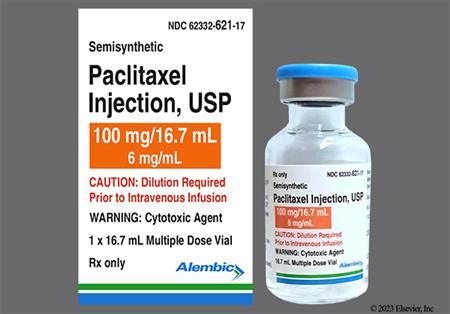
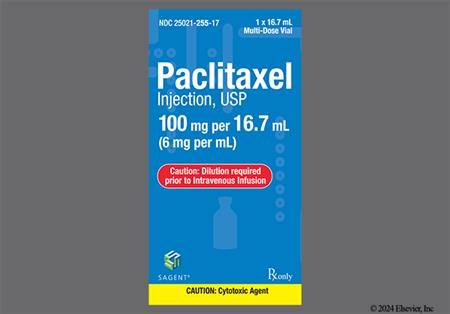
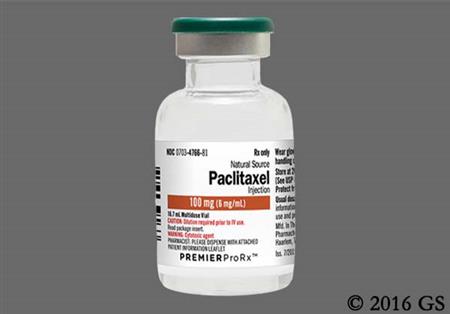
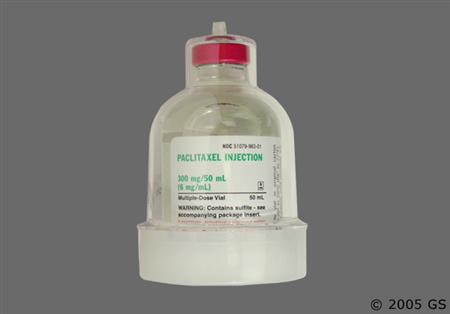
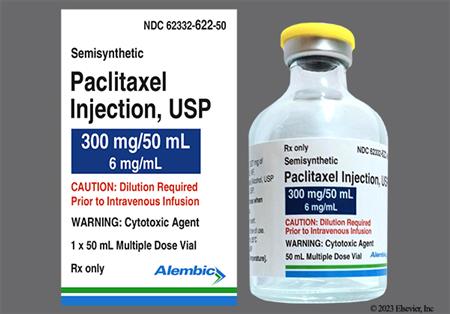
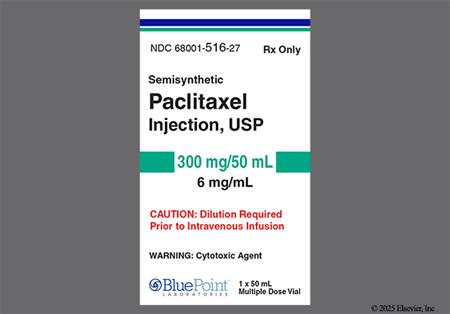
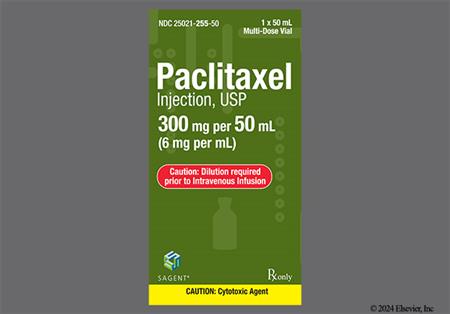
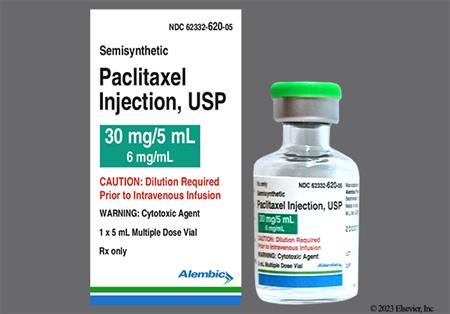
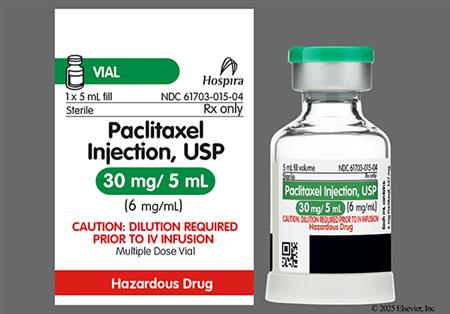
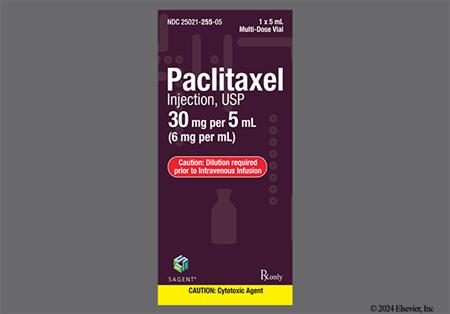
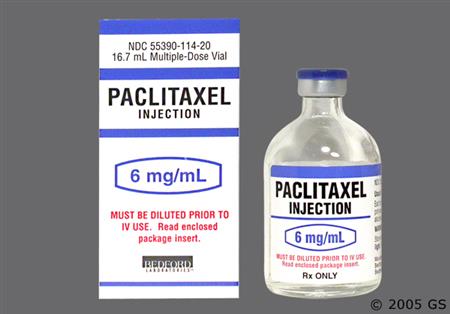
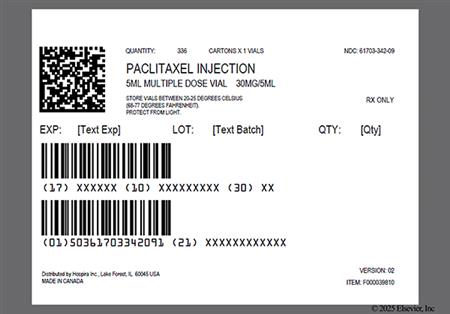
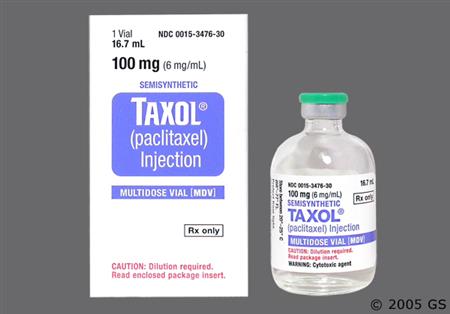
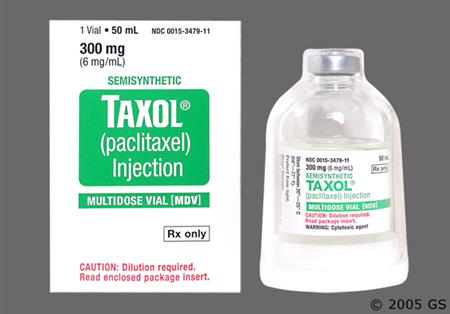
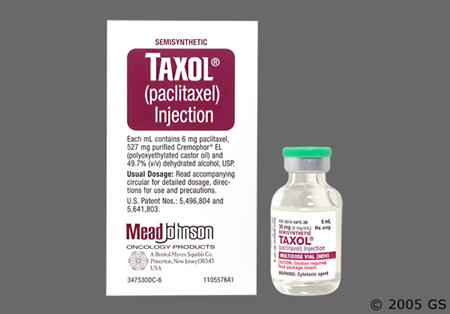
NOTE: Abraxane (paclitaxel bound to albumin), a specialized formulation of paclitaxel, is discussed in a separate monograph.
Paclitaxel is a semisynthetic antineoplastic agent. It is a diterpenoid taxane derivative from the bark of the Pacific yew tree, Taxus brevifolia. Paclitaxel was first discovered in 1971 as a result of the National Cancer Institute (NCI) screening program for natural cytotoxic products. Procurement and stability issues hindered the availability of paclitaxel for clinical use. Paclitaxel injection is very insoluble in water and requires formulation with Cremophor EL and ethanol. In 1991, an agreement between Bristol-Myers Squibb and the NCI led to the development alternative sources of paclitaxel. Paclitaxel has subsequently been isolated from other members of the Taxus genus and is produced by Taxomyces andreannae, a fungal endophyte isolated from the inner bark of the Pacific yew. The production of a semisynthetic form of paclitaxel using the precursor 10-deacetyl-baccatin III, which is found in the needles of the European yew, Taxus baccata, has allowed large supplies to be produced. Due to its unique mechanism of action, paclitaxel has been studied as a single agent and in combination with other chemotherapy agents in the treatment of many solid tumors including ovarian, breast, lung and head and neck cancers. The combination of paclitaxel and a platinum analog is considered the chemotherapy regimen of choice for women with stage III and IV ovarian cancer. Paclitaxel is part of first-line and adjuvant therapy for non-small cell lung cancer. The determination of the optimal dose and scheduling of paclitaxel continues to be investigated. Newer regimens include weekly and biweekly administration as well as shorter infusion times. The sequence of administration of paclitaxel in combination with other chemotherapy agents plays a critical role in toxicity and efficacy of the combination. Several new formulations of paclitaxel are in clinical trials and include a topical paclitaxel gel for psoriasis, a liposome-encapsulated intravenous product, an oral capsule, and a water-soluble, intravenous formulation (Paclical). The FDA provided orphan drug designation for Paclical for the treatment of ovarian cancer; orphan drug designation provides the manufacturer, Oasmia Pharmaceutical, with 7-year market exclusivity on the indication when the pharmaceutical is approved. The FDA first approved paclitaxel in 1992 for the treatment of ovarian cancer. Since this time, Taxol has received approval for a variety of indications including the second-line treatment of Kaposi's sarcoma, treatment of metastatic or relapsed breast cancer after failure of combination chemotherapy, adjuvant treatment of node-positive breast cancer following standard doxorubicin-based combination chemotherapy, and treatment of non-small lung carcinoma in combination with cisplatin.
For storage information, see the specific product information within the How Supplied section.
Hazardous Drugs Classification
Emetic Risk
Extravasation Risk
Dilution:
Infuse IV according to the prescriber's directions as infusion times may vary according to indication. Paclitaxel has been administered as a 3-hour or a 24-hour IV infusion.[29200] Paclitaxel doses up to 100 mg/m2 IV weekly have been given as a 1-hour IV infusion.[42143]
Intraperitoneal infusion:
Bone marrow suppression is the dose-limiting toxicity of paclitaxel. Results of pooled studies of single agent paclitaxel (given as 135 to 300mg/m2 over 3 or 24 hours) in the treatment of ovarian or breast cancer (n=812) demonstrate the following hematologic-related adverse reactions: neutropenia 90% (< 2000/mm3) and 52% (< 500/mm3); leukopenia 90% (< 4000/mm3) and 17% (< 1000/mm3); thrombocytopenia 20% (< 100,000/mm3) and 7% (< 50,000/mm3); and anemia 78% (< 11 g/dl) and 16% (< 8 g/dl). Bleeding was reported in 14% of patients. Red cell transfusions were necessary in 25% of patients and platelet transfusions occurred in 2% of patients. Neutrophil nadirs generally occur at a median of 11 days after paclitaxel treatment. When paclitaxel was given as part of combination therapy for Kaposi's sarcoma, ovarian, breast, or lung cancer during clinical trials, the incidence of hematologic toxicity was similar to single paclitaxel. In adjuvant breast cancer paclitaxel trials, the incidence of severe thrombocytopenia and platelet transfusions increased with higher doses of doxorubicin. Generally, the next cycle of paclitaxel should not be given until the baseline neutrophil count is > 1500 cells/mm3 and the platelet count is > 100,000 cells/mm3. If severe neutropenia (< 500 cells/mm3 for >7 days) occurs during therapy, the addition of colony-stimulating factors or a 20% reduction in paclitaxel dose is recommended for subsequent cycles. The incidence and severity of paclitaxel-induced myelosuppression are more significantly influenced by the duration of infusion versus the dose given.[29200] When given as a weekly infusion, myelosuppression is mild and does not appear to be cumulative even with prolonged therapy. Moderate leukopenia (WBC < 2000/mm3) was noted when paclitaxel was given intraperitoneally at doses >= 175mg/m2.[25770] In a phase III trial where paclitaxel IV was given in combination with intraperitoneal (IP) cisplatin and paclitaxel, leukopenia (WBC < 1000/mm3) and a platelet count < 25,000/mm3 occurred more frequently in those receiving the IP therapy, compared to those in the IV arm of the trial (76% vs. 64% and 12% vs. 4%, respectively). Other hematologic events occurred at a similar incidence in the 2 groups.[32309] Intraperitoneal paclitaxel given weekly at doses of 75 mg/m2 were associated with Grade 2 leukopenia.[32303]
Fever (12% all treatment courses) was reported in paclitaxel clinical trials with or without infection. Febrile neutropenia was noted in 2—55% of patients. Other general adverse events reported include asthenia (17% of paclitaxel plus cisplatin patients), malaise, and anorexia. Edema was reported in 21% of all patients (17% without baseline edema) with only 1% of patients reporting severe edema. This was most commonly focal and disease-related.[29200]
Serious hypersensitivity reactions or anaphylaxis characterized by dyspnea requiring treatment, a drop in blood pressure requiring treatment, angioedema, and generalized urticaria has occurred in 2 to 4% of patients in paclitaxel clinical trials. Other severe reactions include chest pain (unspecified) and tachycardia. Fatal reactions have occurred despite premedication. Results of pooled studies of single agent paclitaxel (given as 135 to 300mg/m2 over 3 or 24 hours) in the treatment of ovarian or breast cancer (n=812) demonstrated an overall incidence of hypersensitivity reactions in 41% of patients and 20% of all courses. There is no apparent dose or schedule effect for hypersensitivity reactions; 3-hour infusions are not associated with increased hypersensitivity reactions as compared to 24-hour infusions. Minor hypersensitivity reactions include mild flushing (28%), skin rash (unspecified) (12%), low blood pressure (4%), dyspnea (2%), tachycardia (2%), and high blood pressure (1%). Cases of chills, anaphylactic shock, back pain, abdominal pain, pain in the extremities, and diaphoresis in association of hypersensitivity reactions have also been noted. Mild reactions do not require interruption of therapy. However, severe reactions require immediate discontinuation of paclitaxel therapy and aggressive symptomatic management. Although this reaction may occur with any course of therapy, it usually happens with the first or second; no severe reactions have been reported after the third course. The reaction usually occurs within the first hour of the treatment course. Manufacturer recommended prophylaxis against hypersensitivity includes dexamethasone 20 mg 6 hours and 12 hours prior to paclitaxel administration followed by cimetidine 300 mg and diphenhydramine (or an equivalent) 50 mg 60 minutes prior to paclitaxel administration.[29200] Patients who have experienced a severe hypersensitivity reaction should not be retreated with the drug.[29200]
Extravasation of paclitaxel is associated with an acute and delayed injection site reaction.[25525] Injection site reactions are more frequently observed during 24-hour infusions opposed to 3-hour infusions. Injection site reactions occurred in 13% of patients (n=812) in studies of single agent paclitaxel (given as 135—300 mg/m2 over 3 or 24 hours) in the treatment of ovarian or breast cancer. Reactions were usually mild and included erythema, tenderness, skin discoloration, or swelling at the injection site. More severe reactions include phlebitis, cellulitis, induration, skin exfoliation, fibrosis, and tissue necrosis.[29200] It appears that both the paclitaxel and the Cremophor EL (polyoxyethylated castor oil) vehicle may both contribute to the skin reactions.[46236] The onset of the reaction may be during a prolonged infusion while other times it may be delayed by 7—10 days. There are also reports of 'recall' reactions at the site of previous extravasation with subsequent paclitaxel administration. Currently there are no consistent guidelines for the management of paclitaxel extravasation.[29200] Local injection of hyaluronidase (150 units in 3 ml) may be beneficial in treating severe paclitaxel extravasation. Conflicting data exist regarding topical heating and cooling.[46236]
Myalgia and arthralgia occur in 60% of paclitaxel patients; severe reactions were reported in 8% of patients. Symptoms are usually transient and usually occur 2—3 days following paclitaxel administration and then resolve within a few days. It is important to distinguish arthralgia and myalgias from treatment-related neuropathies. The intensity and frequency of arthralgias and myalgias tend to increase with increasing dose of paclitaxel, especially doses >= 190 mg/m2. They do not seem to be related to the duration of the infusion.[29200] In a study comparing 250 mg/m2 IV over 3 or 24 hours, the incidence of grade 3 arthralgia/myalgia was 19% for both treatment arms.[25774] Myalgia is common in the shoulder and paraspinal muscles. Arthralgias are common in the large joints of the arms and legs. Acetaminophen is not effective treatment even for mild symptoms. Non-steroidal anti-inflammatory agents such as ibuprofen may be used for the treatment of paclitaxel associated arthralgias and myalgias. For moderate or severe symptoms, corticosteroids or opiate agonists may be appropriate for short-term management. Anticonvulsants and tricyclic antidepressants have also been used for severe symptoms. Prophylactic administration of dexamethasone in patients who are predisposed to arthralgia and myalgia beginning on day 3 following paclitaxel infusion has been effective. The regimen of dexamethasone is 4 mg PO twice daily for 3 days, followed by 4 mg PO daily for 3 days.
Transient skin reactions have been reported, secondary to paclitaxel hypersensitivity reactions; however, no other significant skin reactions have been significantly associated with paclitaxel administration. Maculopapular rash, pruritus, Stevens-Johnson syndrome, and toxic epidermal necrolysis have been reported after administration. In post-marketing surveillance, diffuse edema, thickening, and sclerosing of the skin have been reported. Exacerbation of the signs and symptoms of scleroderma has also been noted. Nail changes including pigmentation changes or nail discoloration, has been reported in 2% of patients during paclitaxel therapy.[29200]
Hypotension during the first 3 hours of infusion occurred in 12% of patients and 3% of courses. Hypotension may also be associated with a hypersensitivity reaction (4%) in some patients and may require therapy. Bradycardia occurred in 3% of patients and 1% of all courses. These effects were usually asymptomatic. Neither dose or infusion schedule effect the incidence of hypotension or bradycardia. Prior anthracycline therapy also does not affect the incidence of hypotension or bradycardia. Close monitoring of vital signs during paclitaxel infusion is recommended. Severe cardiac conduction abnormalities occurred in about 1% of patients. Severe cardiovascular events occur rarely and may include syncope, rhythm abnormalities, hypertension, and venous thromboembolism. Cardiac arrhythmias included asymptomatic ventricular tachycardia, bigeminy, and complete AV block requiring a pacemaker. Cases of myocardial infarction have been reported. Congestive heart failure has been reported with paclitaxel primarily in patients who have received prior anthracycline therapy. Abnormalities in the ECG were reported in 23% of 812 patients in studies of single agent paclitaxel (given as 135—300mg/m2 over 3 or 24 hours) in the treatment of ovarian or breast cancer. In patients with a normal baseline ECG (n=559) in the pooled studies, abnormal ECGs were observed in 14% of patients. The most frequent ECG abnormalities reported were non-specific repolarization abnormalities, sinus bradycardia, sinus tachycardia, and premature beats. Among patients with normal ECGs at baseline, prior to anthracycline therapy did not influence the incidence of ECG changes. Atrial fibrillation and supraventricular tachycardia (SVT) have also been reported. When paclitaxel is used in combination with doxorubicin for the treatment of metastatic breast cancer, monitoring of cardiac function is recommended. In patients with non-small cell lung cancer treated with paclitaxel in combination with cisplatin, significant cardiovascular events occurred in 12—13% of patients. The apparent increase in cardiovascular events could be due to the increased cardiovascular risk factors in patients with lung cancer. Patients with cardiac disease should be carefully monitored while taking paclitaxel. Continuous cardiac monitoring is recommended for patients with serious cardiac conduction abnormalities.[29200]
Peripheral neuropathy has been observed in as many as 60% (3% severe) of all patients treated with single-agent paclitaxel and in 52% (2% severe) of the patients without pre-existing neuropathy. The frequency and severity of neurologic reactions were dose-dependent in patients receiving single agent paclitaxel. The incidence of peripheral neuropathy increases with increasing cumulative paclitaxel doses. Paresthesias commonly occurred in the the form of hyperesthesia. Neurologic symptoms are observed in 27% of patients after the first course and 34—51% from courses 2—10. Some studies have shown an increase in the incidence of neurotoxicity with 3-hour infusions and may be due to increased AUC levels of paclitaxel, high paclitaxel peak serum concentrations, or both. Weekly therapy has been associated with mild to moderate neuropathies in the majority of patients. Severe reactions have been noted with weekly paclitaxel doses > 100 mg/m2. Symptoms usually begin 1—3 days after treatment and resolve within 3—6 months after the drug is discontinued. Development of severe symptoms requires a paclitaxel dose reduction of 20%. Sensory neuropathies occur most commonly but motor neuropathies may develop as well. Patients may lose vibratory, temperature, and pin-prick sensation. Loss of deep tendon reflexes, fine motor skills, and unsteady gait can also occur. These effects usually follow a stocking-and-glove pattern. Pre-existing neuropathy is not a contraindication for paclitaxel; although, these patients may be at increased risk to develop paclitaxel-induced neurotoxicity. Neuropathy has been the cause of discontinuation of paclitaxel in 1% of patients treated with paclitaxel alone. When paclitaxel is given in combination with cisplatin, sensory-motor neuropathy is common and can be dose-limiting. Patients who receive increased doses of paclitaxel with cisplatin had more pronounced neurotoxicity. Paclitaxel 175 mg/m2 over 3-hours plus cisplatin 75 mg/m2 results in an increased incidence and severity of neurologic reactions as compared to cyclophosphamide and cisplatin, 87% (21% severe) versus 52% (2% severe), respectively. Also, patients with pre-existing neuropathy had exacerbations of the neuropathies at lower doses of paclitaxel when given in combination with cisplatin.[29200] Intraperitoneal paclitaxel was associated with an increased incidence of severe or life-threatening neurologic events as compared to IV therapy (19% vs. 9%) in a phase III trial.[32309]
In pooled studies of single agent paclitaxel (given as 135—300 mg/m2 over 3 or 24 hours) in the treatment of ovarian or breast cancer (n=812), common gastrointestinal adverse effects included nausea and vomiting (52%), diarrhea (38%), and stomatitis/mucositis (31%); these effects are usually mild to moderate in severity. Mucositis occurs more frequently with 24-hour paclitaxel infusions versus 3-hour infusions. Reports have also included intestinal/GI obstruction, intestinal/GI perforation, pancreatitis, ischemic colitis, dehydration, esophagitis, constipation, and ascites. Typhlitis (neutropenic enterocolitis) has been reported with paclitaxel administered as single agent and in combination with other chemotherapy agents.[29200] When given intraperitoneally, the dose limiting toxicity is the development of severe abdominal pain, which occurs at doses > 175 mg/m2.[25770] Intraperitoneal paclitaxel given weekly at doses of 75 mg/m2 were associated with Grade 2 abdominal pain, nausea, and vomiting.[32303]
Alopecia is one of the most common adverse reactions to paclitaxel. Hair loss is usually complete and occurs over the entire body. It has been reported to occur in 87% of patients [29200], but probably occurs in 100%. Most patients will lose all scalp hair after the first treatment. Other body hair, including eyebrows, will be lost with subsequent treatments.
Paclitaxel has been associated with a radiation recall reaction.[29200] In patients who have received previous radiation, paclitaxel may cause erythema, exfoliative dermatitis, pain, and burning similar to that experienced with the prior radiation therapy. Radiation pneumonitis has been reported in patients receiving concurrent paclitaxel and radiation therapy.[29200] Paclitaxel acts as a radiation sensitizer and may increase the incidence of radiation pneumonitis. Bilateral pneumonitis has been reported. In one series, patients developed interstitial infiltrates either during or within 6 hours of the administration of paclitaxel 200 mg/m2 IV over 3 hours. Symptoms reported included nonproductive cough, dyspnea, and oxygen desaturation. The symptoms responded to parenteral corticosteroids.[25775] Interstitial pneumonia, pulmonary fibrosis, and pulmonary embolism have also been reported during paclitaxel therapy. Rare cases of interstitial pneumonitis, lung fibrosis, and pulmonary embolism have been reported during safety surveillance for paclitaxel. Pleural effusion and respiratory failure have also been reported.[29200]
Elevated hepatic enzymes have been reported in patients following paclitaxel treatment. In pooled studies of single agent paclitaxel (given as 135—300 mg/m2 over 3 or 24 hours) in the treatment of ovarian or breast cancer to patients with normal baseline hepatic function, reported increases were as follows: elevated bilirubin/hyperbilirubinemia (7%), elevated alkaline phosphatase (22%), and elevated AST (19%). There was no relationship to dose or schedule and prolonged exposure was not associated with cumulative hepatotoxicity. Compared to patients with solid tumors, patients with Kaposi's sarcoma have a higher incidence of elevated hepatic enzymes. Currently, there is no evidence to suggest that elevation in liver enzymes or hepatic dysfunction alters the effect of paclitaxel. If significant hepatic dysfunction occurs, dosages of paclitaxel may need to be reduced (see Dosage). There have been reports of hepatic necrosis and hepatic encephalopathy leading to death .[29200]
In Kaposi's sarcoma patients treated with paclitaxel, 18—34% of patients had increased serum creatinine and 5 patients had Grade 3 or 4 renal toxicity. One patient with suspected HIV nephropathy of grade 4 severity had to discontinue therapy. The other 4 patients had renal insufficiency with reversible increases in serum creatinine. Patients with gynecological cancers treated with paclitaxel in combination with cisplatin may have an increased risk of renal failure (unspecified) than patients treated with cisplatin alone. Compared to patients with solid tumors, patients with Kaposi's sarcoma have a higher incidence of renal toxicity.[29200]
Infection was reported in 30% of patients in studies of single agent paclitaxel (given as 135—300 mg/m2 over 3 or 24 hours) in the treatment of ovarian or breast cancer. Infection was associated with fatalities in 1% of patients and included sepsis, pneumonia, and peritonitis. Urinary tract infections and upper respiratory tract infection were the most common infectious episodes. In immunocompromised patients with advanced HIV-disease and Kaposi's sarcoma, 61% (range 54—76% in studies) reported at least one opportunistic infection. These infections included cytomegalovirus (27—45%), herpes simplex (11—38%), Pneumocystis carinii (14—21%), M. avium intracellulare (4—24%), esophageal candidiasis (7—9%), cryptosporidiosis (7%), cryptococcal meningitis (2—3%), and leukoencephalopathy (2%).[29200]
Other than peripheral neuropathy serious neurologic reactions following paclitaxel administration are rare (< 1%) and have included grand mal seizures, syncope, ataxia, and neuroencephalopathy (encephalopathy). Rarely, autonomic neuropathy resulting in paralytic ileus has been reported. Convulsions, dizziness, headache, and confusion have also been reported. In pediatric patients, CNS toxicity has been associated with paclitaxel doses of 350—420 mg/m2 IV over 3 hours. This toxicity is probably due to the high ethanol content of the vehicle given over a short period of time and the concurrent administration of antihistamines. However, the potential effects of paclitaxel on the CNS status of children cannot be ruled out. Paclitaxel also contains dehydrated alcohol USP (396 mg/ml); therefore, consideration should be given to possible CNS effects associated with alcohol.[29200]
Optic nerve and/or visual disturbances (scintillating scotomata) have been reported with the use of paclitaxel, especially in patients receiving higher than recommended doses. These effects have generally been reversible; however, some cases suggest the possibility of persistent optic nerve damage. Post-marketing reports have also included ototoxicity, specifically hearing loss and tinnitus. Other adverse events that have been reported include conjunctivitis, increased lacrimation, photopsia, visual floaters, and vertigo.[29200]
Paclitaxel is contraindicated in patients who have a history of severe paclitaxel hypersensitivity; those patients with a history of other taxane hypersensitivity should be given paclitaxel with caution. A risk of serious hypersensitivity reactions or anaphylaxis has been reported in patients receiving paclitaxel. Patients with known polyoxyethylated castor oil hypersensitivity should not receive the Taxol formulation or should receive it cautiously and with premedication. Polyoxyethylated compound (Cremophor EL) is believed to be responsible for anaphylactoid reactions. Severe hypersensitivity reactions (e.g., acute bronchospasm and/or hypotension) have occurred despite antihistamine (H1- and H2-blockers) and corticosteroid premedication. Hypersensitivity reactions may occur within minutes of beginning an infusion. Severe may reactions necessitate the immediate discontinuation of the infusion. Patients should be monitored closely.
Paclitaxel is associated with dose-related bone marrow suppression. It should not be given to patients with severe thrombocytopenia or neutropenia, with solid tumors who have baseline neutrophil counts of less than 1,500 cells/mm3, with AIDS-related Kaposi's sarcoma, or with baseline neutrophil count is less than 1000 cells/mm3; these patients may have more frequent and severe hematologic toxicities, infections (including opportunistic infections), and febrile neutropenia compared to patients with solid tumors. In all patients, blood counts should be monitored frequently during treatment. Generally, the next cycle should not be given until neutrophils reach 1500/mm3 and higher (1000/mm3 for Kaposi's sarcoma patients) and platelets recover to 100,000/mm3 or higher. In patients with a neutrophil count of less than 500 cells/mm3 for longer than 1 week, consider adding colony-stimulating factor support or reducing subsequent paclitaxel doses by 20%. Due to these severe adverse reactions, paclitaxel requires an experienced clinician knowledgeable in the use of cancer chemotherapeutic agents. Administration requires a specialized care setting such as a hospital or treatment facility so that facilities are readily available for appropriate management of complications. Use cautiously in patients who have myelosuppression due to previous therapy such as other chemotherapy or radiotherapy; these patients may be more susceptible to the myelosuppressive effects of paclitaxel. Patients with active infection should be treated prior to receiving paclitaxel. Patients with a history of varicella zoster, other herpes infection (e.g., herpes simplex), or other viral infection are at risk for reactivation of the infection when treated with chemotherapy.[29200]
Severe conduction abnormalities have been documented in during paclitaxel therapy and in some cases requiring pacemaker placement. If patients develop significant cardiac conduction abnormalities during paclitaxel infusion, appropriate therapy should be administered and continuous cardiac monitoring should be performed during subsequent therapy with paclitaxel. Patients with cardiac disease including angina, cardiac arrhythmias including AV block, history of congestive heart failure, or myocardial infarction within the past 6 months should be carefully monitored during paclitaxel therapy due to the potential for serious cardiac complications. In addition, patients receiving paclitaxel in combination with doxorubicin for metastatic breast cancer should be considered for cardiac monitoring. In a review of gynecologic cancer patients with major risk factors who received paclitaxel, no evidence of additive adverse effects was noted. As many of the reports of severe cardiac events were seen in early trials of paclitaxel as a result of hypersensitivity reactions, appropriate premedication appears to have decreased the incidence of these effects. It should be noted that patients with severe conduction abnormalities were not included in this review.[25773] Because bradycardia is a common adverse reaction, patients receiving drugs known to cause bradycardia, such as beta-blockers, calcium-channel blockers, and digoxin, also should be monitored carefully.[29200]
Paclitaxel should be used cautiously in patients with known hepatic disease. Because paclitaxel is extensively metabolized through cytochrome P-450 system, excessive toxicity may occur in patients with hyperbilirubinemia and elevated liver enzymes. Limited data suggest myelotoxicity may be increased in patients with serum bilirubin > 2 times ULN. Patients with hepatic disease may require dose reductions (see Dosage).[29200]
Paclitaxel is classified as FDA pregnancy risk category D and has been shown to produce toxic effects, including death, in fetal animal studies. There are no data concerning the effects in pregnant women. Therefore, paclitaxel should be avoided during pregnancy, and females of childbearing potential should be instructed to avoid becoming pregnant during paclitaxel therapy. If a women becomes pregnant while receiving this drug, she should be counseled of the potential harm to the fetus and the possibility of loss of pregnancy.[29200]
It is unknown whether paclitaxel is excreted into human breast milk; paclitaxel was excreted into the breast milk of lactating rats at concentrations higher than those seen in plasma. Because of the potential for serious adverse reactions in nursing infants, patients should be instructed to discontinue breast-feeding during paclitaxel therapy.[29200]
The Taxol formulation of paclitaxel contains a high concentration of ethanol (49.7% (v/v)). Consideration should be given to the CNS effects and other effects of alcohol. Special consideration may be prudent in individuals with alcoholism or a history of substance abuse. Patients should be cautioned regarding driving or operating machinery following infusion of Taxol as the high alcohol content infused over a short period of time may theoretically cause impairment in some persons.
Mechanism of Action: Paclitaxel is an antimicrotubule chemotherapy agent. Although both bind to tubulin, the mechanism of action of paclitaxel differs from the vinca alkaloids. Paclitaxel promotes the assembly of microtubules and stabilizes their formation by inhibiting depolymerization. These microtubules are extremely stable and non-functional. In addition to functioning as components of the spindle apparatus within the cell, normal microtubules also maintain cell shape, assist in cellular motility, attachment, and intracellular transport, and modulate interactions with growth factors. The primary effect of paclitaxel is to inhibit the cell cycle during mitosis. Paclitaxel also inhibits the transition from G0 to S phase by disrupting tubulin in the cell membrane and/or direct inhibition of the disassembly of the cytoskeleton interrupting intracellular transport and communications.
Microtubules are in equilibrium with tubulin heterodimers, the building blocks of microtubules, which consist of alpha- and beta-subunits. Paclitaxel reversibly binds to the N-terminal 31 amino acids of the beta-tubulin subunit of the microtubule rather than the tubulin subunits. The binding site of paclitaxel is different from the binding site of colchicine, epipodophyllotoxins, and vinblastine. Paclitaxel shifts the equilibrium towards microtubule assembly. Cells treated with paclitaxel show distinctive morphologic effects. Multiple bundles of microtubules are noted in paclitaxel treated cells. These bundles form during all phases of the cell cycle. Abnormal spindle asters are formed during mitosis. Paclitaxel also induces the expression of tumor necrosis factor-alpha and inhibits angiogenesis, although the exact roles of these actions in the cytotoxic effects of paclitaxel is not known. Paclitaxel acts as a radiation sensitizer due to its ability to stop the cell cycle during the premitotic G2 and mitotic phases, which are the most sensitive to the effects of radiation.
Paclitaxel will induce varying intracellular effects depending upon the intracellular concentration and cell type. In vitro studies have shown a minimum concentration for cytotoxic effects. As the taxane concentration increases, the dose-response decreases. Prolonged exposure to taxanes is critical to cytotoxicity and is more important than increasing the drug concentration.
Resistance to paclitaxel may develop via two different mechanisms. Alterations in the alpha- and beta-tubulin subunits can decrease the rate of polymerization into microtubules. When this occurs, administration of taxanes may actually normalize the rate of microtubule assembly. The second mechanism is through multidrug resistance (MDR), which results in decreased intracellular drug accumulation and retention. This mechanism of resistance primarily affects naturally occurring chemotherapy agents. MDR is due to overexpression of the mdr-1 gene, which encodes for a membrane P-glycoprotein (P-gp) that acts as a drug efflux pump. The degree of resistance is proportional to the amount of P-gp. There is not complete cross-resistance between the taxanes and anthracyclines; the exact role of MDR in paclitaxel resistance has not been determined.
Revision Date: 10/15/2025, 01:33:00 AMPaclitaxel is given by IV administration; an oral formulation is undergoing clinical evaluation. Paclitaxel undergoes nonlinear pharmacokinetics due to saturable distribution and/or metabolism. Nonlinear pharmacokinetics are especially evident when administered over shorter periods (i.e., 3 hours) versus initial studies of 24-hour or longer infusions. Clinical implications of the nonlinear pharmacokinetics include disproportionate increases in AUC, peak plasma concentrations, and toxicity with dose increases, while dose reductions may lead to decreased cytotoxicity. Tissue sites are saturated at relatively low concentrations (those achieved with < 175 mg/m2 over 3 hours) and metabolism is saturated at higher doses (>= 175 mg/m2 over 3 hours). Peak tissue concentrations do not change significantly doses are increased from 135 to 250 mg/m2 administered as 3- or 24-hour infusions. The rate and extent of tissue saturation are greater with shorter infusion schedules.[25762] Neutropenia and, to a lesser extent, neurotoxicity have been associated with exposure of cells above a critical plasma concentration (> 0.05 micromolar/L) or increased duration of exposure and do not correlate to dosage.
Paclitaxel is extensively protein bound (95—98%) to tissue proteins, especially tubulin. It is widely distributed throughout the body except for the brain and testes. Following a 3-hour infusion the alpha-half-life is 16 minutes, beta-half life is 140 minutes, and final elimination half-life is about 19 hours.[25763] Paclitaxel is metabolized primarily via cytochrome P-450 (CYP) isoenzymes 2C8 to 6-alpha-hydroxypaclitaxel, and to a lesser extent by 3A4 to minor metabolites 3'-p-hydroxypaclitaxel and 6-alpha,3'-para-dihydroxypaclitaxel. Alterations of metabolism may occur when drugs affecting the CYP system are given concurrently. In addition, sequence-dependent drug interactions have been documented with paclitaxel and other chemotherapy agents. Elimination is due to hepatic metabolism, biliary and fecal excretion, and tissue binding. Approximately 70—80% of the dose is eliminated in the feces within 1 week. Only 1—8% of paclitaxel is eliminated unchanged in the urine.
Affected cytochrome P450 isoenzymes and drug transporters: CYP3A4, CYP2C8, P-gp
Paclitaxel is a substrate of the cytochrome P450 (CYP) isoenzymes 2C8 and 3A4, and of the multidrug resistance protein, P-glycoprotein (P-gp).[28498][49806][58751]
Paclitaxel has poor oral availability due to its high affinity for P-glycoprotein, a multi-drug transport enzyme present in high levels in the GI tract. In clinical studies, oral paclitaxel has been given in combination with cyclosporine to improve the bioavailability, as cyclosporine blocks the activity of P-glycoprotein (see Drug Interactions).
Intraperitoneal route
When given intraperitoneally (IP), exposure to the peritoneal cavity exceeds plasma exposure by about 1000-times. Paclitaxel is slowly cleared from the peritoneal cavity resulting in significant concentrations persisted within the peritoneal cavity for > 24—48 hours after a single IP administration.[25770] The prolonged terminal half-life when given IP is thought to be due to Cremophor El diluent used in the Taxol product. In one small trial, the terminal half life of IP paclitaxel was 28.7 +/- 8.72 hours versus a terminal IV half-life of 17 +/- 11.3 hours.[32312] The systemic bioavailability of IP paclitaxel in this study was 31.4 +/- 5.18%. Elimination from ascites fluid is also extremely slow with detectable levels still present after 18 days and an apparent disappearance half-life in ascites fluid of about 140 hours.[32312]
Appropriate dose adjustments in patients with hepatic dysfunction have not been determined and patient specific evaluation is required. In a small study examining the safety of paclitaxel in patients with elevated bilirubin concentrations and liver enzymes, doses needed to be reduced. Patients who received paclitaxel over 3 hours had serum concentrations > 0.05 micromolar/L for longer than expected, when compared to historical controls. Patients with increased serum AST levels but normal bilirubin levels experienced more toxicity and did not tolerate single doses > 50 mg/m2 given over 24 hours.[25764] It has been recommended to reduce paclitaxel doses by at least 50% in patients with moderate or severe hyperbilirubinemia or substantially increased serum AST levels.
Dosage adjustments in patients with renal impairment are not required.
Paclitaxel is classified as FDA pregnancy risk category D and has been shown to produce toxic effects, including death, in fetal animal studies. There are no data concerning the effects in pregnant women. Therefore, paclitaxel should be avoided during pregnancy, and females of childbearing potential should be instructed to avoid becoming pregnant during paclitaxel therapy. If a women becomes pregnant while receiving this drug, she should be counseled of the potential harm to the fetus and the possibility of loss of pregnancy.[29200]
It is unknown whether paclitaxel is excreted into human breast milk; paclitaxel was excreted into the breast milk of lactating rats at concentrations higher than those seen in plasma. Because of the potential for serious adverse reactions in nursing infants, patients should be instructed to discontinue breast-feeding during paclitaxel therapy.[29200]
Cookies are used by this site. To decline or learn more, visit our cookie notice.
Copyright © 2025 Elsevier, its licensors, and contributors. All rights are reserved, including those for text and data mining, AI training, and similar technologies.